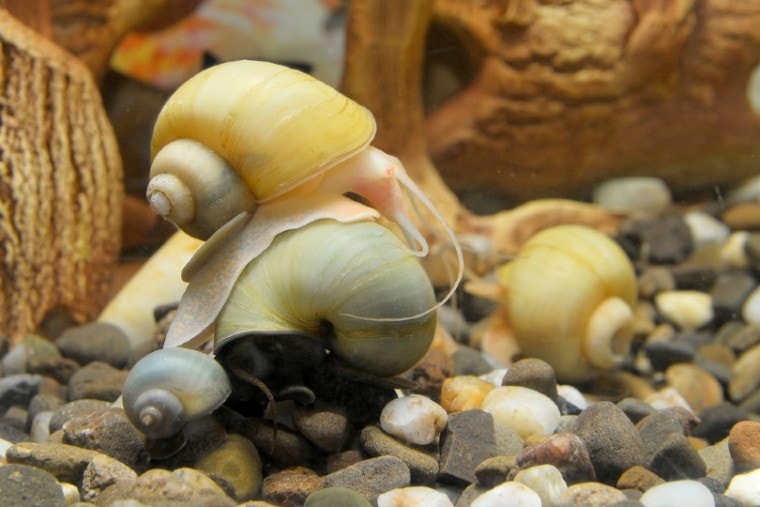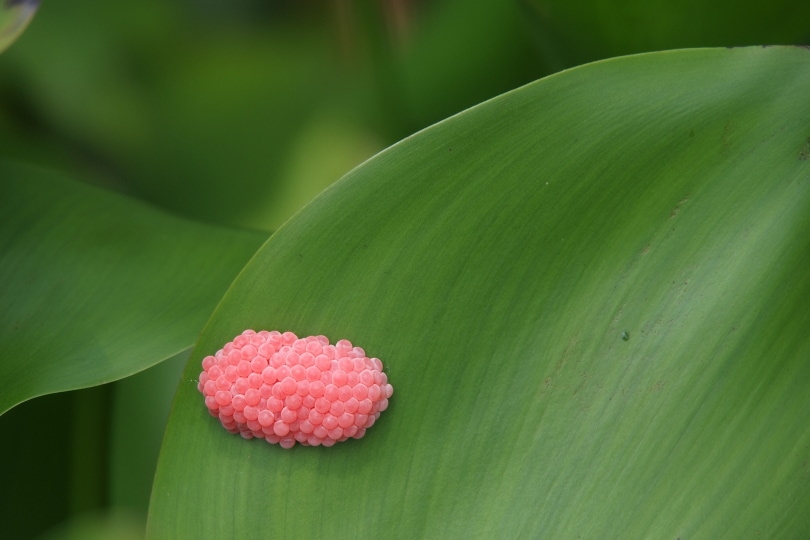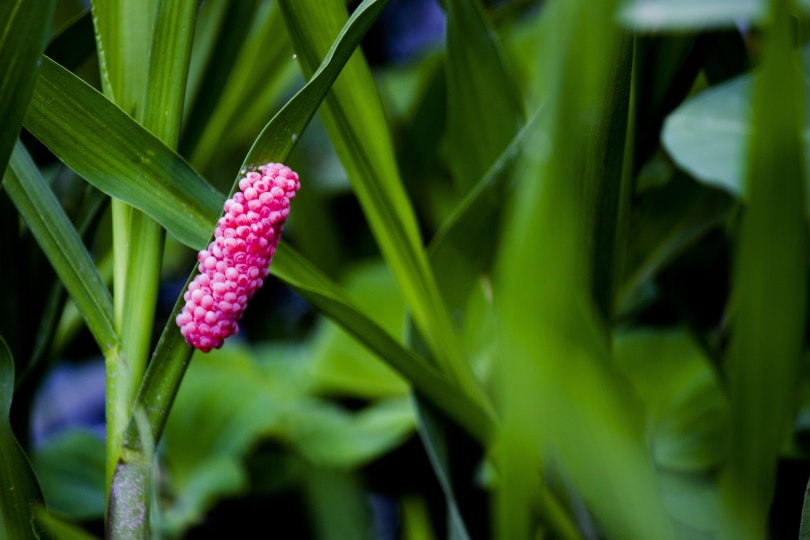
Mystery snails are fantastic snails that are active and fun to watch. If you’ve grown to love these snails with big personalities, then you may have wondered what it entails to breed them yourself. Well, you’ve likely seen that the breeding itself isn’t the hard part, so here’s everything you need to know about breeding your mystery snails.
The 5 Simple Steps to Breed Mystery Snails
1. Prep the snails
To make sure your snails are in their best breeding condition, make sure you are feeding a highly nutritious diet with plenty of calcium. Blanched veggies, like zucchini and spinach, algae wafers, calcium supplementation, and homemade snello can all be great ways to help your snails meet their protein and calcium needs. Bloodworms, daphnia, and other frozen foods can be thawed and fed to your snails as a treat for additional protein.
2. Raise the temperature
To start prepping the tank, slowly raise the water temperature over a few days if your tank isn’t already above 73˚F. Mystery snails can be in water up to 78˚F for breeding purposes, but likely won’t require temperatures that high to stimulate breeding.

3. Lower the waterline
Mystery snails lay their eggs above the waterline and usually prefer to have around 4 inches available for this task. Lowering the waterline in your tank will help your snail have plenty of space to lay her clutch safely. The clutch should never be kept underwater as this will drown the developing embryos. If you don’t leave enough egg-laying space in the tank, your female may choose not to lay, but it’s not uncommon for you to find egg clutches on the wall near the tank if your female finds a way out.
4. Watch for breeding
Breeding behavior entails the male snail mounting the female snail for up to 4 hours. This may happen multiple times per day or per week. It’s extremely important that you keep an eye out for frequent breeding because male snails have been known to overbreed females, which can kill them from stress. If your male is mounting your female multiple times per day, then it may be time for him to go to a bachelor tank for days, weeks, or longer while your female gets a break.

5. Monitor for clutches
Female mystery snails prefer to lay their eggs under cover of darkness, so it’s unlikely that you’ll spot your female laying her eggs. Check your tank over at least every morning to see if there are clutches anywhere. Females can get pretty creative with where they lay their clutches, so check under the edges of the rim, behind filters, and even on the lid of the tank.
Make a Plan
The most important part of breeding mystery snails is knowing what you’re going to do with them after they hatch! Mystery snail clutches can hatch a few dozen to a few hundred young! Statistically, a portion of the young won’t survive after hatching, but you still could end up with dozens of baby mystery snails. You know what baby mystery snails do?
They grow. They also produce a heavier bioload than most other snails.
So, if you don’t want to be stuck performing daily water changes in your 30-gallon tank filled with 200 full-sized mystery snails a few months down the road, you need to know exactly where those babies are going to go. Local fish stores will often buy snails from locals once they reach around dime size, but you’ll have to check with the store well in advance to make sure they’ll actually buy the snails from you. You can also consider trying to sell them independently on marketplaces or your own website, but make sure you’re well-versed in the sale and ownership of mystery snails in your area and in areas you’re planning to ship to.
If you’re thinking to yourself, “a bunch of my friends said they want some baby snails,” remember that out of every 10 people who told you they’d take a snail, at least half will likely back out. Unless you have 300 friends wanting baby snails, relying on friends to take them off your hands isn’t a good idea.
Sexing Mystery Snails
First of all, yes, mystery snails have set sexes. That means you need a male and a female to reproduce, and they cannot change their sex. No matter what the person at the pet store told you, mystery snails cannot reproduce asexually and cannot change their sex.
Second, it’s difficult to sex mystery snails. They do have genitalia that you can spot, but in order to see this, you’ll have to hold the snail out of the water and on its back, and then the snail will have to almost fully extend from the shell for you to see the genitalia. Sexing mystery snails can be extremely difficult for professionals and breeders, so the high school kid working a summer job at the pet store likely won’t be able to determine the sex of a snail either.
Honestly, your best bet at ending up with a male and female mystery snail is to get more than one snail and hope for the best, unless you’re very confident in your or someone else’s ability to determine the sex.
Oh, and if you’ve seen your snail waving something around and you thought that meant it’s a loud and proud male snail, what you’re likely seeing is the siphon. The siphon is part of the respiratory system of mystery snails, and they will extend it from their body, sometimes multiple inches, to pull in oxygen.
Color Breeding
If you have your heart set on breeding for a specific color of mystery snail, then your best bet is to have both parents of the same color. If you have multiple colors and you let them freely breed, then you may end up with all kinds of surprises. Keep in mind, though, that if you go to the pet store and get two gold mystery snails, this doesn’t guarantee you’ll get all gold babies. Why? Because both parents carry the genetics of their parents, grandparents, and so forth. If you don’t know the color lineage of both parents back at least three or more generations, then you can guess what colors are most likely but not guaranteed. If you breed two gold mystery snails, you’ll likely end up with all gold babies, but you also may end up with jade, which is a gold shell and a dark foot, or something entirely unexpected.
Where’d These Eggs Come From?
If you currently only have one mystery snail and you wake up one day to an egg clutch in the tank, you’ll likely wonder what happened. No, your mystery snail didn’t defy the laws of science and asexually reproduce. Female mystery snails can hold onto genetic material for around 9 months! What this means for you is that your snail bred before you brought her home and she woke up one morning and though, “today’s the day!”
It is also possible for females to lay unfertilized egg clutches without the presence of a male. If you’ve had your snail for a year or more, this is most likely the case. If you’ve only had your snail for a few months, only time will tell if the clutch is fertile or not.
Caring for the Clutch
 Conclusion
Conclusion
Breeding mystery snails isn’t a difficult task, but it does require care and time on your part, especially once eggs have been laid. Have a solid plan for what you’ll do with the babies once they’re old enough and keep a close eye on the breeding process to protect your female snail. Breeding your snails can be fun and rewarding, though, especially when you get unexpected color surprises!
Related Read:
- Everything You Need to Know About Mystery Snails
- 3 Snello Recipes for Breeding & Keeping Snail Shells Healthy
Featured Image by: badahos, Shutterstock








